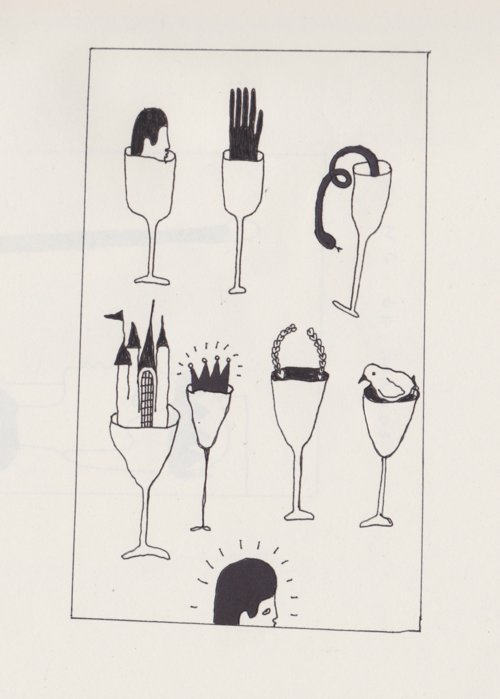
Illustrations by Josephine Demme
In this series five different writers talk to one writer about five (or more) of his different books. In this second interview, Brian Conn talks to Brian Evenson about Immobility. Read the first interview with Colin Winnette, the second with Matt Bell.
Brian Conn in Conversation with Brian Evenson
I was kicked out of a reading room at the Providence Public Library while rereading Brian Evenson’s Immobility. I had been there for several hours when an oily man in a crooked tie approached me. “This room is for students and people with laptops,” he said, looking away. “Not for casual reading.”
Well, the rules are the rules. But as I walked out of the library I wondered whether the oily man’s accusation of “casual reading” was justified. Is Immobility casual reading? I still do not have an answer to this question. Immobility is a science fiction novel featuring scenes of graphic violence, a description that suggests the kind of novel that might be read casually. But it is also a novel about not knowing who or what you are; and that theme is not developed casually, but is instead integrated so thoroughly that by the time you reach the end you are likely to have forgotten forever what you once meant by the word “human.”
That is not among the usual effects of casual reading.
There’s a deadpan humor in some of Evenson’s writing. The scene in Immobility in which one of Horkai’s keepers holds him down while the other prepares the bone saw is a strangely funny scene. It’s a scene that elevates your heart rate and your breathing rate and maybe it just seems funny because you don’t know what else to do with that excitement.
Maybe that’s nervous laughter. After all it is a bone saw. It cannot be serious. It is apparently serious. Evenson offers us no help in understanding whether he is serious or not, whether or not this is a casual book. His language (the substrate of narrative) tells us that we do not know what language is, that language does not know what language is, that we are all blind.
Since so many of the usual categories break down when applied to Evenson’s work, for this interview we had recourse to magic. I spoke to him in his office at Brown University.
—Brian Conn
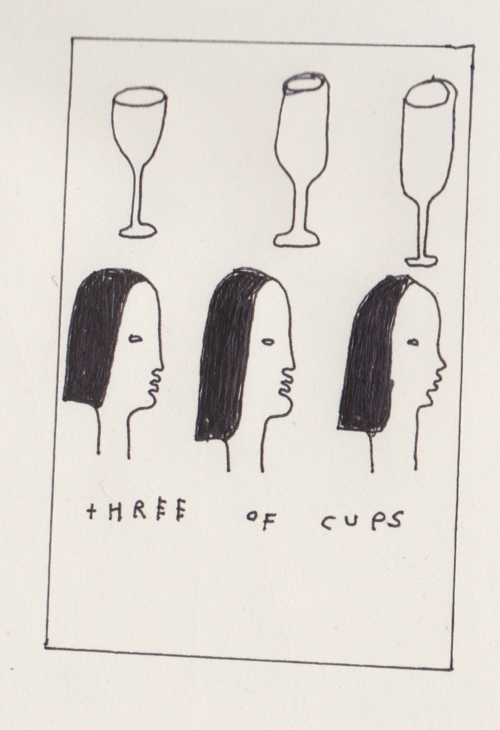
I. THE THREE OF CUPS
BRIAN CONN: I brought tarot cards. I had this idea that we should use them to talk about Immobility. I don’t know if you spend much time with tarot cards.
BRIAN EVENSON: A little.
BC: I’ve spent a lot of time with the major arcana. Let’s take those out and only use the minor arcana, so you and I will have equal knowledge. I’ve also brought Arthur Edward Waite’s Pictorial Key to the Tarot. We could take three cards, one after the other. The first we could use to talk about Immobility. With the second we could focus more on you and your habits as a writer. And the third—I think you said once that this book might be part of a longer series, that there’s a larger world here?
BE: Right.
BC: So maybe the third card we could use to talk about that stuff. I don’t have a particular ceremony. Should we just look at the top card?
BE: Sure. It’s the three of cups.
BC: The three of cups. Maybe we should look at it before we consult Arthur Waite. What do you think is there?
BE: Well, there are three cups. Everyone is raising a cup, so there’s a kind of festive or joyous mood. The number three is obviously important in the three of cups, but also in my work, I think.
BC: In Immobility particularly?
BE: Well, in Immobility there are three people who are traveling, but there’s a duo within the trio. It’s a triple that isn’t ever completely triple.
BC: I was rereading the book yesterday and the day before, and I became interested in the difference between the two Q characters, the duo—whose names I’ve never pronounced. How do you pronounce them?
BE: I’d say Kahn-ik and Kaht-ik.
BC: Qanik and Qatik. They do seem to have different characters, and they may even change over the course of the book.
BE: They do have a little bit different characters. One of them is always talking about how he’s older, that he came first.
BC: Qatik is older.
BE: That’s right. One of the problems with naming two characters with very similar names is that you can’t always keep track of which is which—but that’s part of the book too. And I think one of them starts to become more cynical, and fights against that. The other one is more accepting, and serves as a kind of anchor. Neither of them seems quite independent, and as a result there is the sense that they’re exchanging ideas, or personalities. One says something, and the other picks it up and then it changes a little bit, and the other one picks up the changed words. That’s something that I’ve done for a long time, something that happens in “Two Brothers”—that’s the story that does it the most profoundly, where the two brothers end up switching personalities at a certain point.
BC: And in Immobility there’s another trio on the other side, with another pair of twins, Olaf and Oleg, and Rasmus makes a third with them.
BE: Right, so you have two trios, and then within those trios there’s two sets of twins and a single figure that seems to be in a different position. Rasmus seems to be in charge in that trio. He’s directing and controlling those two. In the case of the other set, Horkai’s not sure what his relationship is to Qanik and Qatik. They seem to feel like he’s in charge, but also he doesn’t seem to know anything about what’s going on, and they seem a little puzzled by the fact that everything that seems obvious to them doesn’t seem obvious to him.
BC: And there are also, in a sense, three different versions of humanity in the book.
BE: Right. Rasmus and his group are representing people who seem to be just humans as we know them. Then there are these twins who seem to be humans who have been “made” in some way, and who may not be exactly human—the details aren’t really gone into—but there’s the sense that they’re manufactured, that other people see them as animals or mules or something lesser in some regard. A big part of the book is Horkai coming to a sense of connection with them. He’s a kind of post-human, someone who was human but is becoming more intensely human or becoming something else entirely. And what that is, exactly, is unclear at this point. There are certain characteristics they seem to have—they’re very hard to kill, they seem to heal very rapidly, they seem to absorb whatever it is that’s toxic about the environment in a way that rejuvenates them. There’s the sense that they have adapted. And everyone who Horkai has met who seems to be in this position, has very different feelings or ideas about it.
BC: And there’s another three if you like, three different ways of responding to the situation—Rykte is one, and the Granite Mountain guys, and Rasmus’s hive. Do you deliberately sit down and structure things by threes?
BE: No. I think it’s partly that I was trained as a Hegelian. My PhD was on post-Hegelian French thought, so I think I naturally fall into these kinds of—not only triples, but also doubles. So it’s not that there’s just the twins, it’s that there’s two sets of twins. Everything seems to replicate itself in strange ways.
BC: Temporally too, there’s a lot of repetition and variation of certain scenes.
BE: There’s the sense, in this book, that Horkai’s always waking up, he’s always trying to figure out where he is.
BC: Are there any cups in the book?
BE: You know, I don’t know if there’s a single cup in the book, to be honest. I’m trying to think. When they’re in the silo, I can’t remember if they’re sipping water out of a cup or not. It may be that he has a collapsible cup. I had a collapsible cup when I was a cub scout. I think, in fact, there may not be any cups.
BC: An interesting omission. Is a cup a peculiarly human artifact?
BE: It is a specifically human artifact. I can’t remember where in the Bible it is, but there’s a distinction made between people who lap like a dog and people who use their hands to cup the water and drink it, and that ends up making a cultural distinction—which, if I remember right, is probably used to slaughter people. As, ultimately, is the case with most cultural distinctions.
BC: People who don’t drink water correctly get slaughtered?
BE: I think maybe, but I may just be wrong about that. I’m probably putting two things together.
BC: So no cups—does that say something about the absence of the human in Immobility?
BE: One of the things that was behind this book—years ago I was somewhere with Gordon Lish, and he said to me, “It seems like what you’re doing in your work is trying to figure out what it would be like to tie your shoes if you were completely outside of civilization and didn’t know that shoes existed but were suddenly wearing them.” And I think that’s such a weird paradox in some ways—how does that change things? How do objects—things that we just see, take for granted as tools or things that are natural—how do they change if they’re taken out of their context or if the world changes in some way? There’s a great moment in Kant’s Critique of Judgment in which he talks about objects that once had use-value that have become useless, and struggles to try to decide how to think about them aesthetically. He talks about it in terms of purposiveness without purpose. I think a lot of my work involves people having something that they have to figure out to use in some way, and use for different purposes than intended, which is probably a reaction to my father’s insistence that a screwdriver was exclusively for screwing in screws.
So in Last Days there’s a kind of doctor’s mirror, kind of like a dentist’s mirror, that’s on a long stem—pretty small, something that would fit in your pocket that you could use to look down someone’s throat—and Kline in that book, in the bed, has to figure out other things to do with it as a way of saving himself. I think a lot of my work is about people repurposing objects or living in spaces that are partly ruined and trying to make sense of them—to navigate the spaces with things that should probably be used for other purposes.
BC: My sense is that all the characters here, other than Horkai, have hold of some ossified fragments of civilization, and they have some very definite idea about how these fragments are supposed to be used. So the hive has a fragment of some communal philosophy, but they’re not using it in any way that we would consider normal, and the people in Granite Mountain have this religious fragment.
BE: And they both seem to be so certain about how the world should be, or how they want the world to be, but it’s like taking these broken ideas and these broken codes and trying to apply them in ways that don’t make sense.
BC: And Horkai is the only one who doesn’t think he knows how to apply the ruins, what to do with the ruins.
BE: He holds back in certain situations. There is this sense in him of waiting to see what will happen, a hesitation. And it’s very different from Rykte’s waiting, which is this more active rejection of everything. But at the same time, Rykte lives in an old house, he’s replaced the windows, he’s figured out what his neighborhood is like, he’s growing mushrooms in the basements. He has this generator working to preserve the stuff that Horkai’s found, things like that.
BC: Rykte’s not part of this world in the same way as the others. He’s withdrawn, and he’s not helping anyone, and he’s not hurting anyone – or that’s what he says, and he has a philosophy to support that. At first the philosophy seems very sound. When we first meet him in the book, he’s saying what we’ve been thinking. But as we spend more time with him, it begins to seem as though he also is holding onto something that’s a little bit broken. He’s holding onto a different kind of ruin. And we don’t go there, you don’t show us—you don’t remove that bit of rubble from the pile of rubble and show us the piece.
BE: He’s deliberately a little bit obscure as a character. That’s partly the idea I have for the second book: he’ll be in a position where he has to actually make a decision to do something or act, and there may be consequences. I think in a way a lot of his philosophizing is a way of keeping himself from having to look at or think about certain things.
BC: All those things that Horkai doesn’t know about—there’s ultimately some certainty to them, but he just doesn’t have access. And all the questions he doesn’t have the answers to, in fact, do have answers. Does the same pattern apply to the situation humans find themselves in here—is there a correct way of understanding it, and we just have to figure it out?
BE: No, I would say there’s not. What should happen with the world itself—what the right answer is, what the right position is—I don’t feel like I know. I feel like all the groups have good points, I can understand why they do what they do, but I don’t know that any of them is quite right. I also don’t think there’s an easy way to synthesize them. And that’s the difficulty. That’s my anti-Hegelian streak.
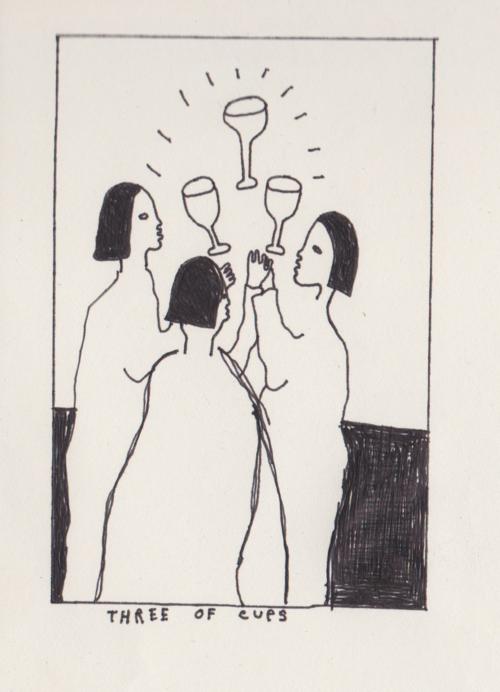
The Pictorial Key to the Tarot: Maidens in a garden ground with cups uplifted, as if pledging one another.
BE: This is something that’s strange about this book, that there are almost no female figures. In that sense it’s a very patriarchal book—there are all these strange groups of men with different philosophies who are just set on destroying one another other.
BC: In the card they’re “pledging” one another.
BE: The pledge is something—there’s a lot that’s done to Horkai to try to make him feel like he owes something to the group, or that he has a responsibility.
BC: Does he have a responsibility?
BE: When you look at what humans have done to the environment and to the world and to one another, it’s easy to start thinking, well, maybe humans should die out. But at the same time, you’re human, and so that’s an intellectual position you can take, but—I don’t know, I think that humans probably should have a shelf-life like so many other creatures have had. The ethics of all that is complicated. I don’t want to make an argument for Gaia or some other such nonsense. The more I talk about this, the more I start sounding like Rykte.
BC: Do you identify with Rykte?
BE: Of all the people in the book he’s probably the one I identify with the most, except for maybe Horkai. Somewhere within that continuum between the two of them I think is where I fall.
BC: The continuum of responsibility to humans?
BE: Yes. Rykte has decided he doesn’t owe anything to the community, he doesn’t have any involvement, he can keep his distance and do what he wants to do, and if he has to kill people he’ll do it. And Horkai still feels that sense of connection. There’s something that’s driving him to go back, even though he knows it’s probably not a good idea.
BC: The other thing on this card is a garden in the background, which is one more thing that’s very conspicuously absent in the book.
BE: There are a couple of hints that something is coming back, or that something new is coming, but there’s very little there. So this card is more about what’s not in the book. No cups, no maidens dancing in the garden.
BC: But trios and pledges. The abstract elements of the card moved into a space where a lot of the concrete elements have been suppressed.
BE: That makes sense. Very elegantly put.
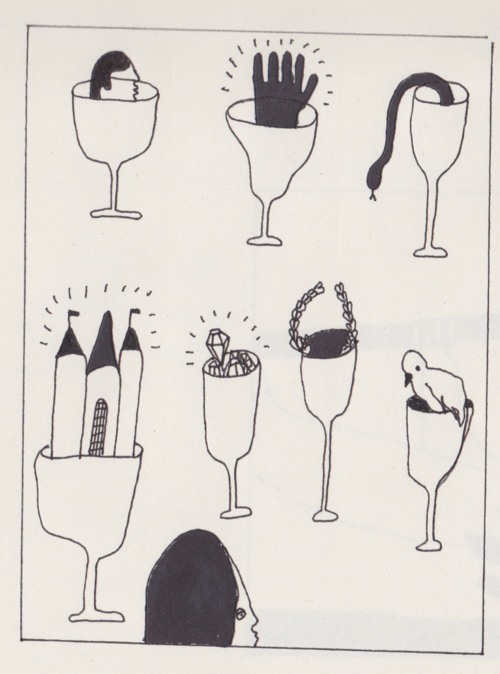
II. SEVEN OF CUPS
BC: Shall we take another card? Let’s use this one to talk about you as a writer, and I suppose we can also take the opportunity to talk about other books, things that have influenced you.
BE: Sure. It’s the seven of cups. It’s a very weird card. There’s a shadowy figure looking at a bunch of cups, each of which has something in it. One has a head in it, which is intriguing. Another has a snake. Another has a figure that seems to be covered with a red cape. It also seems to be vibrating or glowing. One seems to have a kind of mountain or castle. Another has riches and jewels; another has a laurel crown, which to me would represent fame, I suppose. And then I guess that’s some sort of purple crocodile monster?
BC: Which one are you?
BE: I was drawn immediately to the head. I don’t know why, but the idea of a head in a goblet does seem like it’s appropriate to at least some of my work. But also I suppose it’s because we’re thinking about me as a writer that I want to be the head rather than the snake or something else.
BC: Because the writer is the head in the sense that the writer does the thinking?
BE: I suppose so. But at the same time it’s a disembodied head. It’s a head that’s been cut off. And in this book, in Immobility, there’s a sense that the only way Horkai can be killed is if his head is completely severed from his body. And we have this severed head presented in a cup on the card.
BC: There’s a lot to say about that head.
BE: It seems to me like this shadowy figure is being forced to make a choice. Or that he’s regarding all these things, which seem to be illusions.
BC: Do you identify with the shadowy figure too?
BE: Yes. And you can see that the shadowy figure has a head, but you can’t see the characteristic of the head. I think a lot of my work is about choice and making choices. And a lot of my work is about people who are unable to make decisions, or who are paralyzed.
BC: And this figure is making a decision, but it’s a decision among unreal objects.
BE: Yes, I think that’s part of it—what are you actually deciding between, are they palpable things or fantasies? But again I’m not sure what to make of the red-caped figure or the head. I mean, you can see the jewels as wealth, and I guess you could see the castle as real estate. Or, you know, dominion. But the head and the other thing, I just don’t know what to make of them exactly.
BC: Is there a death’s head underneath the wreath, or is it just me?
BE: No, there is a death’s head underneath the wreath. I guess it could be posthumous fame then. That’s not so bad.
BC: Do you think that the writer as head is severed from the body of culture?
BE: Maybe. I think that kind of notion of separation of mind and body is something that I want to resist a little bit. But at the same time I do feel like I’m out of step with what a lot of people are doing in the culture, which is both a good thing and sometimes a bad thing.
The Pictorial Key to the Tarot: Strange chalices of vision, but the images are more especially those of the fantastic spirit.
BC: Is your writing fantastical?
BE: I think there’s always a fantastical element. I’m certainly not doing any kind of hard science fiction, partly because I just don’t know anything. It would be like a baby trying to write a book. I admire that stuff, people like Greg Egan, but it’s just not something I’m good at or really all that interested in writing. But I do think a lot of the work is about things that aren’t real. Immobility is written in a realistic way, so it’s about making the fantastical realistic. There is something about it that’s interested in extrapolating beyond our world. I think that the strength of conventional realism is that it depicts the world we live in, and its weakness is it’s less interested in extrapolating from that world and more interested in just kind of showing how we behave toward one another. The most extreme version of this is a certain sort of minimalism in which everything is leveled out in present tense—there’s nothing but the present. I think it’s playing it too safe to not at least gesture toward what things might become or toward trying to conceive of where things are going. There is something much more audacious about being wrong about how things might play out, which is one of the things that makes early science fiction both really fun and really funny. But the impulse within the fantastic that I like is fantastic fiction that ends up having a philosophical bent, and that ends up exploring the nature of what it means to be human, or what it means to be connected to the world in a certain way. I think there’s lots of science fiction that’s very good at doing that. I don’t think there’s much realism that’s all that good at doing that, to be honest. I just think it’s not exactly the question that realism is most interested in, although there are probably all sorts of exceptions.
BC: In a way the realist move is to limit the scope of the work by just accepting a known set of fantasies ahead of time.
BE: A lot of my work, and a lot of the work I admire by other people, will mimic realism, and then make people feel like they’re accepting this kind of fantasy that just is a kind of given for realism, and then take it away. So something starts out appearing to be a realistic story, and then it changes and becomes challenging and unsettling. And I love that, I love the kind of vertiginousness of that. A lot of my work is really about undermining reality. Partly because reality is basically a construct, at least the way we understand it as humans living within a specific culture. And that goes back to what we were talking about before, to the relics and the rubbish of a culture, and what you do and what you make of it. Culture is a series of rubbish heaps layered one atop the other. The thing that makes a fork a fork is that there’s all this external coding that goes on top of it, and if you don’t have that coding, then it’s something very different. I’ve thought about this a lot for some reason, and I’ve had this experience a lot where I see something and I think it’s something else, and then I get closer and I realize it’s not what I thought.
The example I’ve used in other interviews is that it’s like: you see a bird, it seems injured, and then you get closer and realize it’s actually just a leaf that’s blowing around, that it never was a bird after all. And you’re like, OK, it’s not really a bird—but that doesn’t really capture the nature of that experience, which leaves you feeling a little bit disturbed and unsettled, and makes you feel like somehow that was a bird after all, for at least a little while. One of the impulses in my fiction is trying to capture that sense of not only what’s objectively real or not objectively real, but that notion of the subjective experience of seeing the world in one way and then having that experience change. In one sense you just misunderstood the world to start out with, your sensory input was wrong; in another sense, especially when you start talking about cultural details, it’s completely artificial either way. And when you start to think about it in regard to relationships or things like that, it becomes even more fraught, reality even more evasive.
BC: What’s the difference between your work and some of the popular magical realists, like Garcia Marquez? He’s also trying to merge the real and the fantastical, but it’s not at all unsettling; if anything it’s the opposite.
BE: No, I like his work a lot, but it is a very different impulse. His work has a kind of symbolic weight to it, in terms of the way the magic realism works, that’s very different than what my work does. I think that part of my work is not being able to reduce things to symbols, which I think Garcia Marquez does sometimes. The book of his that I identify most with is The Autumn of the Patriarch. The narrator is the most ambiguous, because it’s a kind of we-narration that breaks into different individual voices as it goes along. Also, he doesn’t always build up a realistic ground that he then dismantles. The realism is something that develops in conjunction with the magical quality of the work. So more often, even from the first sentence of a lot of the stories, you have a kind of sense of the parameters of the world. And as a result you don’t have that kind of unsettling. In a way what I’m doing is making the reader feel like they’re reading one kind of story or book, and then slowly taking that away, and hopefully doing it in a way that doesn’t make them so mad that they don’t want to keep reading. So I guess it’s that his magical realism is just more integrated—that the magical qualities and the realist qualities are integrated and they don’t seem to be working in contradistinction.
BC: It’s like he’s taking what’s inside the human world and expanding it, humanizing the fantastical, whereas you’re instead reaching out and bringing something that’s out there into the human sphere, but without humanizing it.
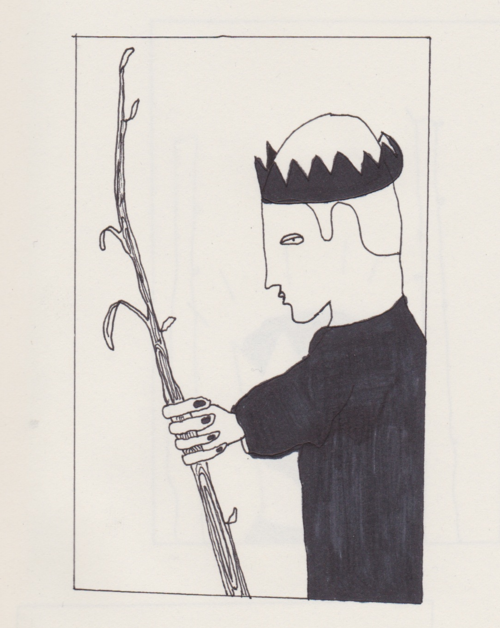
III. KING OF WANDS
BC: Let’s go on to another card. You were talking about future books that you envision in this world, and this third card can be about that. But it can also about other thoughts that you have about Immobility that are somehow beyond the boundaries of the book itself.
BE: It’s the king of wands. So it’s not a cup.
BC: No. What do you see in the king of wands?
BE: Well, the wand seems to be sprouting leaves—which is curious.
BC: It is curious. It has four leaves, it looks like. And it’s also a huge stick, it’s probably as tall as he is, or as tall as he would be, but he’s sitting down.
BE: He’s on a throne, it’s a kind of greenish throne, which is also curious; there’s a sense that that might be a world, or a space. He’s got a nice hairdo.
BC: Is that his hair?
BE: I don’t know if it’s hair, maybe it’s—mail, or something.
BC: How do you feel about him?
BE. He’s a curious fellow. He’s staring off the edge of the card, so there’s this sense of observing and standing back. I like the idea that this wand is sprouting, there’s a kind of creativity that’s attached to that.
BC: Do you see the world of Immobility sprouting in that way?
BE: It’s starting to. I think that there are these little indications. One is that Horkai sees signs of plants coming back a couple of times, and maybe an insect, but I think he says it will be years and years before anything is really thriving. And at one point he’s in what used to be the Capitol building, and he finds an eviscerated body—but he also thinks he sees something up on the top of the dome.
BC: He has two dreams about that earlier too, or visions.
BE: He does. He’s not sure what they are, if they’re dreams or visions or memories. And so that’s likely to figure into future books.
BC: You said the king of wands is staring off the card. Do you feel like this book has set up a frame or a boundary, and future books will be filling out that frame? Or does the frame expand and become about something else?
BE: I think the frame is likely to expand a little bit, but I don’t think dramatically. I mean I’ve thought about that a lot, how far out I want to go, because there’s a real possibility that in other parts of the world different sorts of things are happening, or things are not as bad.
BC: It sounds like it’s expanding in some other dimension.
BE: A question that really interests me is the question of whether consciousness is real, or to what degree it’s something that’s kind of imagined. I’m very interested in philosophers like Thomas Metzinger. There’s the famous experiment that shows that you can have a rubber hand on the table, and hide the subject’s real hand, and the subject starts to feel things that are done to the rubber hand. So it’s about the way in which the mind can recreate these realities and start to see a connection. A lot of those philosophers who are doing stuff with cognitive theory and brain science really think of consciousness as basically an accident that’s not evolutionarily very useful. It’s a side effect in some ways. If we think of our awareness of ourselves as just part of this accident, it calls a lot into question.
The Pictorial Key to the Tarot: The physical and emotional nature to which this card is attributed is dark, ardent, lithe, animated, impassioned, noble.
BE: Sounds all right except for lithe. I don’t think I’m very lithe.
The Pictorial Key to the Tarot: The king uplifts a flowering wand, and wears, like his three correspondences in the remaining suits, what is called a cap of maintenance beneath his crown.
BE: So that’s what the hair is—a cap of maintenance.
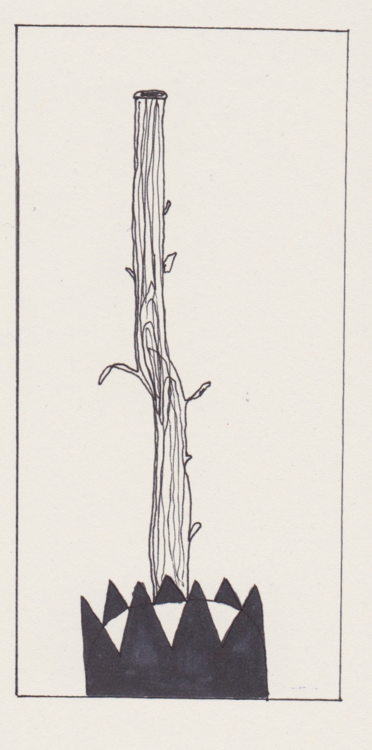
The Pictorial Key to the Tarot: He connects with the symbol of the lion, which is emblazoned on the back of his throne.
BE: I’m a Leo. I was born in August.
BC: Is there anything noble in the world of Immobility?
BE: I don’t know how to even make sense of the word noble. I think it’s an ethical book, in the sense that it presents Horkai with a choice, where he can go back to the hive or not—and he does, but only so he doesn’t feel guilty, so that he can give up, so that he can get away. The only maybe noble thing is when he gives the morphine to the dying mule. I don’t think there’s much that’s noble at all about the novel. It doesn’t really fit with the nature of the book. But the sequence of the three cards is interesting. We start with a card in which people are holding up empty cups, and then we’re presented with a bunch of full cups, and then it seems like in the final card there’s some kind of dominion to this character.
BC: What I notice about these three cards together is that these women on the first one are looking at each other, and then here’s a character looking at something that seems non-human, that’s outside of him; and this last one is a character gazing off the card.
BE: Unless he’s staring at his wand. Which is possible. But my initial impression, too, is that he’s looking off the card. And that red figure with the glow. I keep coming back to that.
BC: Because you’re interested in things that are hidden.
BE: I am. I think that’s probably exactly why.
Week 1: Colin Winnette on Baby Leg and Dark Property.
Week 2: Matt Bell on The Open Curtain




